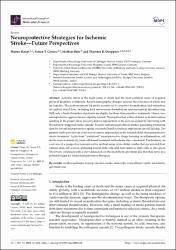| dc.contributor.author | Haupt, Matteo | |
| dc.contributor.author | Gerner, Stefan T. | |
| dc.contributor.author | Bähr, Mathias | |
| dc.contributor.author | Doeppner, Thorsten R. | |
| dc.date.accessioned | 2023-03-27T10:41:11Z | |
| dc.date.available | 2023-03-27T10:41:11Z | |
| dc.date.issued | 2023 | en_US |
| dc.identifier.citation | Haupt, M., Gerner, S. T., Bähr, M. ve Doeppner, T. R. (2023). Neuroprotective strategies for ischemic stroke—Future perspectives. International Journal of Molecular Sciences, 24(5). https://dx.doi.org/10.3390/ijms24054334 | en_US |
| dc.identifier.issn | 1661-6596 | |
| dc.identifier.uri | https://dx.doi.org/10.3390/ijms24054334 | |
| dc.identifier.uri | https://hdl.handle.net/20.500.12511/10706 | |
| dc.description.abstract | Ischemic stroke is the main cause of death and the most common cause of acquired physical disability worldwide. Recent demographic changes increase the relevance of stroke and its sequelae. The acute treatment for stroke is restricted to causative recanalization and restoration of cerebral blood flow, including both intravenous thrombolysis and mechanical thrombectomy. Still, only a limited number of patients are eligible for these time-sensitive treatments. Hence, new neuroprotective approaches are urgently needed. Neuroprotection is thus defined as an intervention resulting in the preservation, recovery, and/or regeneration of the nervous system by interfering with the ischemic-triggered stroke cascade. Despite numerous preclinical studies generating promising data for several neuroprotective agents, successful bench-to-bedside translations are still lacking. The present study provides an overview of current approaches in the research field of neuroprotective stroke treatment. Aside from “traditional” neuroprotective drugs focusing on inflammation, cell death, and excitotoxicity, stem-cell-based treatment methods are also considered. Furthermore, an overview of a prospective neuroprotective method using extracellular vesicles that are secreted from various stem cell sources, including neural stem cells and bone marrow stem cells, is also given. The review concludes with a short discussion on the microbiota–gut–brain axis that may serve as a potential target for future neuroprotective therapies. | en_US |
| dc.language.iso | eng | en_US |
| dc.publisher | MDPI | en_US |
| dc.rights | info:eu-repo/semantics/openAccess | en_US |
| dc.rights | Attribution 4.0 International | * |
| dc.rights.uri | https://creativecommons.org/licenses/by/4.0/ | * |
| dc.subject | Cerebral Ischemia | en_US |
| dc.subject | Extracellular Vesicle | en_US |
| dc.subject | Microbiota–Gut–Brain Axis | en_US |
| dc.subject | Neuroprotection | en_US |
| dc.subject | Stem Cells | en_US |
| dc.subject | Stroke | en_US |
| dc.title | Neuroprotective strategies for ischemic stroke—Future perspectives | en_US |
| dc.type | review | en_US |
| dc.relation.ispartof | International Journal of Molecular Sciences | en_US |
| dc.department | İstanbul Medipol Üniversitesi, Rektörlük, Sağlık Bilim ve Teknolojileri Araştırma Enstitüsü | en_US |
| dc.authorid | 0000-0002-1222-9211 | en_US |
| dc.identifier.volume | 24 | en_US |
| dc.identifier.issue | 5 | en_US |
| dc.relation.publicationcategory | Diğer | en_US |
| dc.identifier.doi | 10.3390/ijms24054334 | en_US |
| dc.institutionauthor | Doeppner, Thorsten R. | |
| dc.identifier.wosquality | Q1 | en_US |
| dc.identifier.wos | 000947494300001 | en_US |
| dc.identifier.scopus | 2-s2.0-85149976556 | en_US |
| dc.identifier.pmid | 36901765 | en_US |
| dc.identifier.scopusquality | Q1 | en_US |



















